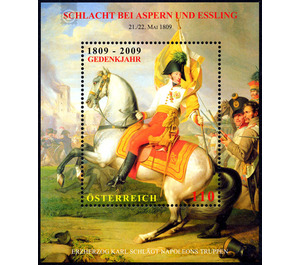200 years Aspern Battle Essling - Austria / II. Republic of Austria 2009
Theme: Animals
| Country | Austria / II. Republic of Austria |
| Issue Date | 2009 |
| Edition Issued | 300,000 |
| Item Type | Block |
| Chronological Chapter | OOS-OE2 |
| Chronological Issue Number | Block 52 |
| SID | 833442 |
| In 54 Wishlists | |
Aspern, located on the left bank of the Danube, is only about half an hour's walk from Essling. To the east and north of it spreads the Marchfeld, which is bounded on the west by the Bisamberg. In the latter was the army of Archduke Karl, who had retreated to the Danube after the unfortunate fighting at Regensburg. He was determined to defend against Napoleon the strategically important point where the roads to Bohemia, Moravia and Hungary unite. The French arrived in Vienna on 13 May and stood on the right bank of the Danube, almost 90,000 strong, ready to cross them. As a transition point Napoleon chose the place where the Lobau is enclosed by two arms of the Danube. On May 20, the French then began the crossing over the northern branch of the river and occupied the villages Aspern and Essling; By the next day, about 30,000 men had made it to the left bank of the Danube - in the manner that Masséna stood at Aspern, Lannes near Essling, and Napoleon himself between them, when Archduke Karl and his army strode to attack the French to throw them back over the Danube, to destroy the bridges and to occupy the banks with artillery. Only after a long struggle, and after the attack on the Austrian infantry had failed, succeeded Archduke Karl to displace the French from Aspern. Anders in Essling: Here failed the attacks of the Austrians, the French remained in the possession of the place. During the night, after the ruined bridge was restored, Napoleon had most of his army transfer to the left bank of the Danube and began fighting again. Again it was about the ownership of the two villages: The Austrians tried Essling to conquer the French Aspern. Napoleon personally led his main thrust in the center - but after a fierce fight, the French were pushed back into the marshy floodplains. Napoleon could no longer stand on the left bank of the Danube and ordered the nightly retreat. In his bulletin, he later presented the course of the battle in such a way that he repulsed the enemy, broke off the battle in the midst of the victory and ordered the retreat. But the truth soon prevailed, provoking alarm in Paris, new hope in the Tyrol and northern Germany, and faith in Prussia's accession to the Alliance against Napoleon. Archduke Karl had tremendously shattered the aura of Napoleon's invincibility.


